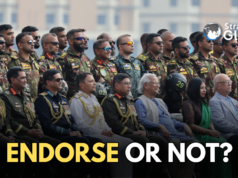
India’s turbulent relationship with Pakistan has been marked by repeated cycles of conflict, terrorism, and proxy warfare—a pattern documented in a new chronology by NatStrat that tracks major Pakistan-origin attacks on India over nearly eight decades.
The report, covering incidents from 1947 to 2025, outlines how Pakistan’s military and intelligence establishment used covert warfare, extremist groups, infiltration, and hybrid tactics to target India repeatedly and systematically.
According to NatStrat, a New Delhi-based strategic think tank, the story begins with the 1947–48 invasion of Jammu & Kashmir, when thousands of Pashtun tribal militias and Pakistani Army regulars entered the region under “Operation Gulmarg”, triggering the first India-Pakistan war.
The document notes that the raiders captured Muzaffarabad and Uri, carried out killings and looting in Baramulla, and advanced to within 48 km of Srinagar before India airlifted troops on 27 October 1947 to repel them. It cites the admission of former Pakistani Major General Akbar Khan, who described the operation as a pre-planned intervention disguised as a local uprising.
The report then traces Pakistan’s support for insurgent groups in Northeast India through the late 1960s, when the ISI provided training, shelter, and weapons to Mizo and Naga militants operating along the India–East Pakistan border. Pakistani operatives helped facilitate cross-border movement, supported coordinated attacks on Indian posts, and created safe havens in the Chittagong Hill Tracts and Sylhet.
A major escalation followed in 1965 with Operation Gibraltar, a Pakistan-led infiltration designed to incite an uprising in Jammu & Kashmir. Thousands of Pakistani soldiers disguised as civilians crossed the Line of Control, prompting clashes that widened into the 1965 India-Pakistan war. The document describes Pakistan’s miscalculation that Kashmiris would join the insurgency and highlights India’s eventual counter-offensive that advanced toward Lahore before a UN-brokered ceasefire.
The chronology also covers Pakistan’s 1971 air attacks under Operation Chengiz Khan, which marked the start of the 1971 war, followed by the Indian offensive that led to the creation of Bangladesh and the surrender of 93,000 Pakistani troops. The report notes the mass casualties inflicted on civilians in East Pakistan during the military crackdown known as Operation Searchlight.
Between 1972 and 1989, Pakistan expanded its use of proxy groups, backing hijackings and militancy linked to the Khalistan movement. The hijacking of the Indian Airlines aircraft “Ganga” in 1971 and subsequent attacks by groups such as Al-Fatah and the Kashmir Liberation Army were supported by Pakistani intelligence operatives, who provided arms smuggling channels, training, and logistical support.
The NatStrat report also lists ISI officers who supervised these networks and facilitated operations in both Kashmir and Punjab.
The 1980s saw Pakistan’s covert role in sustaining Sikh militancy through the supply of AK-47 rifles, explosives, and training camps in Lahore and Karachi. The report documents how extremist factions used the Golden Temple complex for arms storage and how the ISI attempted to exploit sectarian grievances to destabilise Indian Punjab. Testimonies cited in the document describe Pakistan-backed plans ranging from coordinated terror attacks to attempts to weaponise civil aviation.
From 1989 onwards, Pakistan shifted its focus sharply to Jammu & Kashmir. The NatStrat timeline describes the “K2 Project,” a coordinated ISI strategy aimed at fuelling simultaneous insurgencies in Punjab and Kashmir. Militancy in Kashmir escalated dramatically with assassinations, kidnappings, ethnic-targeted killings, and attacks on civilians and security personnel. Groups such as the JKLF, Hizbul Mujahideen, Lashkar-e-Taiba (LeT), and Jaish-e-Mohammad (JeM) received extensive assistance through training camps in Pakistan and Pakistan-occupied Kashmir.
The report lists a series of major attacks in the 1990s, including the killing of community leaders, massacres of Kashmiri Pandits, the Hazratbal siege, and the kidnappings of foreign tourists in 1995. It describes attacks such as the 1997 Sangrampora massacre, the 1998 Wandhama killings, and the 2000 Chittisinghpura massacre, attributing them to Pakistan-based groups including LeT.
The 1993 Mumbai bombings, coordinated through 12 powerful explosions that killed 257 people, are described in the report as having links to D-Company and the ISI, which allegedly facilitated RDX supplies and training for the conspirators. Other major incidents detailed include the 1996 Lajpat Nagar blast, the 1998 Coimbatore bombings, and the 1999 IC-814 hijacking, where hijackers linked to Pakistan-based Harkat-ul-Mujahideen forced the release of Jaish-e-Mohammad founder Masood Azhar.
The chronology highlights the 1999 Kargil conflict, describing internal Pakistani admissions that the operation was planned by senior military officers without the knowledge of then-Prime Minister Nawaz Sharif. Pakistani forces occupied heights in the Kargil sector to target India’s supply lines, leading to a two-month-long conflict that India eventually won after intense fighting.
In the 2000s and 2010s, the report lists attacks including the Red Fort attack (2000), the Parliament attack (2001), the 2008 Mumbai attacks, and the 2016 strikes in Pathankot, Uri, and Nagrota—all linked to Pakistan-based groups such as LeT and JeM. The chronology concludes with incidents up to 2025, reiterating Pakistan’s long-term use of terrorism, covert operations, and hybrid warfare.
According to the NatStrat compilation, this pattern of state-backed violence has claimed tens of thousands of civilian and military lives in India over nearly eight decades and continues to shape the security dynamics between the two neighbours.
In a career spanning three decades and counting, Ramananda (Ram to his friends) has been the foreign editor of The Telegraph, Outlook Magazine and the New Indian Express. He helped set up rediff.com’s editorial operations in San Jose and New York, helmed sify.com, and was the founder editor of India.com.
His work has featured in national and international publications like the Al Jazeera Centre for Studies, Global Times and Ashahi Shimbun. But his one constant over all these years, he says, has been the attempt to understand rising India’s place in the world.
He can rustle up a mean salad, his oil-less pepper chicken is to die for, and all it takes is some beer and rhythm and blues to rock his soul.
Talk to him about foreign and strategic affairs, media, South Asia, China, and of course India.




